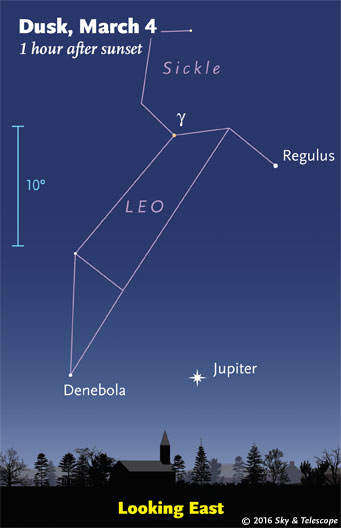
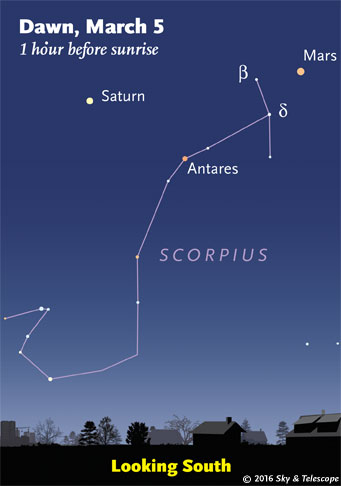
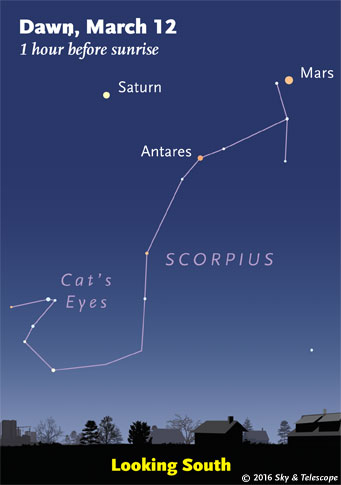
Friday, March 4
• Leo stands over bright Jupiter at nightfall this week, as shown at right.
• The Big Dipper glitters high in the northeast these evenings, standing on its handle. You probably know that the two stars forming the front of the Dipper's bowl (currently on top) are the Pointers; they point to Polaris, currently to their left.
And, you may know that if you follow the curve of the Dipper's handle out and around by a little more than a Dipper length, you'll arc to Arcturus, now rising in the east.
But did you know that if you follow the Pointers backward the opposite way, you'll land in Leo?
Draw a line diagonally across the Dipper's bowl from where the handle is attached, continue far on, and you'll go to Gemini.
And look at the two stars forming the open top of the Dipper's bowl. Follow this line past the bowl's lip far across the sky, and you crash into Capella.
Saturday, March 5
• On the traditional divide between the winter and spring sky is dim Cancer. It's between Gemini to its west and Leo to its east. Cancer holds something unique in its middle: the Beehive Star Cluster, M44. The Beehive shows dimly to the naked eye if you have little or no light pollution. With binoculars it's a snap even in a more polluted sky. Look for it a little less than halfway from Pollux in Gemini to Regulus in Leo.
Sunday, March 6
• As dawn brightens on Monday morning the 7th, look just above the east-southeast horizon for Venus to the right or lower right of the thin waning crescent moon. Binoculars will help. Your best chance will be about 30 to 20 minutes before your local sunrise.
Monday, March 7
• Double shadow on Jupiter. Both Io and Europa will be casting their tiny black shadows onto Jupiter from 7:28 to 8:58 p.m. EST. Jupiter will be well up by then as seen from the Eastern time zone.
Not long after, Jupiter's Great Red Spot will rotate into view. It will cross the planet's central meridian around 11:04 p.m. EST.
Tuesday, March 8
• Jupiter is at opposition. Jupiter is the brightest light in the east these evenings, next to the faint hind foot of Leo. The rest of Leo extends to its upper right.
• New Moon. A total eclipse of the Sun crosses parts of Indonesia and the Pacific from 7:17 to 11:37 p.m. Eastern Standard Time (from 0:17 to 3:37 March 9th Universal Time/GMT). Article. Maps and details.
Webcasts are planned by Exploratorium (7 to 10:15 p.m. March 8th EST; 0:00 to 3:15 March 9 UT), by Slooh (6 to 9 p.m. EST), and on NASA TV (starting 8 p.m. EST; totality at the camera's site will be from 8:38 to 8:42 p.m. EST).
The eclipse is partial across much of East Asia, parts of Australia, and the Pacific including Hawai`i, where the partial eclipse happens during the hour before sunset.
Wednesday, March 9
• To telescope users, Gemini is known for its double star Castor and for the Clown Face Nebula, the planetary nebula NGC 2392. But maybe you didn't know about its four fine open clusters. And what about the asterism O'Neal 9? Explore them with Sue French's Deep-Sky Wonders article, chart and photos in the March Sky & Telescope, page 54.
For a deeper challenge, hunt the faint galaxies that peer through the Beehive Cluster with Ted Forte's Going Deep article, page 57.
Thursday, March 10
• Sirius now blazes due south on the meridian just as twilight fades away into night. Sirius is the bottom star of the equilateral Winter Triangle. The triangle's other two stars are orange Betelgeuse to Sirius's upper right (Orion's shoulder) and Procyon to Sirius's upper left.
Friday, March 11
• Just after dark, look for the crescent Moon low in the west. Upper right of it by about 14° are the leading stars of Aries. The brightest of them is 2nd-magnitude Hamal.
Upper left of the Moon by about the same distance (depending where you are) is 2.5-magnitude Menkar, Alpha Ceti.
Saturday, March 12
• The waxing crescent Moon in the west shines below the Pleiades and Aldebaran this evening.
• Catch Algol at its minimum light, magnitude 3.4 instead of its usual 2.1, for a couple hours centered on about 9:25 p.m. EST.
• Daylight-saving time begins at 2 a.m. Sunday morning for most of North America. Clocks spring ahead.
__________________________
Want to become a better astronomer? Learn your way around the constellations. They're the key to locating everything fainter and deeper to hunt with binoculars or a telescope.
This is an outdoor nature hobby. For an easy-to-use constellation guide covering the whole evening sky, use the big monthly map in the center of each issue of Sky & Telescope, the essential guide to astronomy.
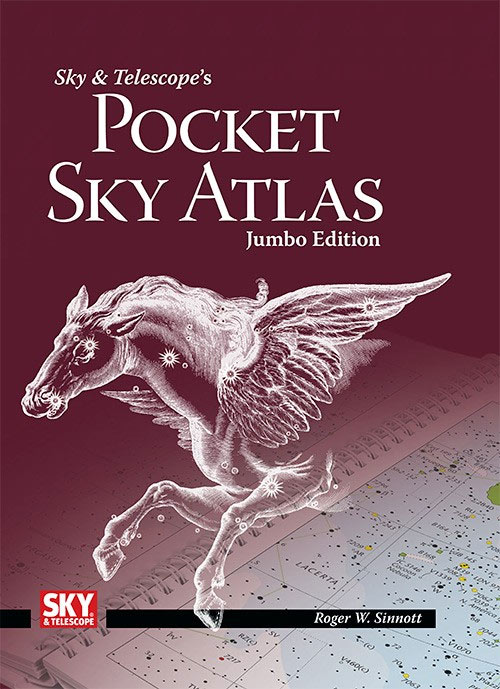
Once you get a telescope, to put it to good use you'll need a detailed, large-scale sky atlas (set of charts). The basic standard is the Pocket Sky Atlas (in either the original or new Jumbo Edition), which shows stars to magnitude 7.6.
Next up is the larger and deeper Sky Atlas 2000.0, plotting stars to magnitude 8.5, nearly three times as many. Next up, once you know your way around, is the even larger Uranometria 2000.0 (stars to magnitude 9.75). And read how to use sky charts with a telescope.
You'll also want a good deep-sky guidebook, such as Sue French's Deep-Sky Wonders collection (which includes its own charts), Sky Atlas 2000.0 Companion by Strong and Sinnott, or the bigger Night Sky Observer's Guide by Kepple and Sanner.
Can a computerized telescope replace charts? Not for beginners, I don't think, and not on mounts and tripods that are less than top-quality mechanically (meaning heavy and expensive). As Terence Dickinson and Alan Dyer say in their Backyard Astronomer's Guide, "A full appreciation of the universe cannot come without developing the skills to find things in the sky and understanding how the sky works. This knowledge comes only by spending time under the stars with star maps in hand."
This Week's Planet Roundup
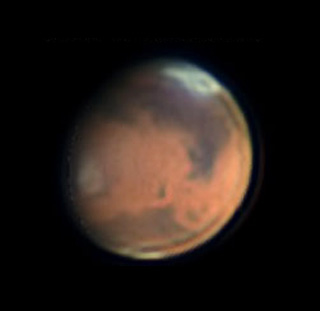
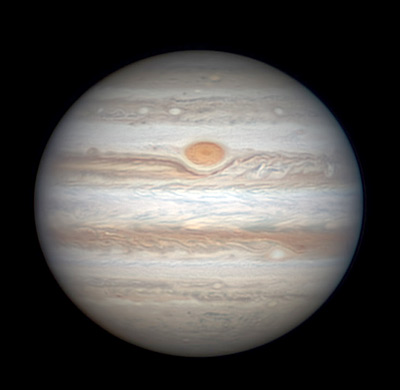
Mercury is lost in the glare of the Sun.
Venus (magnitude –3.8) is just above the east-southeast horizon 20 or 30 minutes before sunrise. Good luck.
Mars (about magnitude +0.2, in Libra), rises around midnight and glows yellow-orange in the south before dawn. In a telescope it's 9 arcseconds in diameter. Can you see surface features yet?
Jupiter (magnitude –2.5, by the hind foot of Leo) is at opposition on March 8th. It shines low in the east as twilight fades, highest in the south around midnight, and sets in the west around sunrise. See our telescopic guide to Jupiter and the doings of its four big moons in the March Sky & Telescope, page 48.
Saturn (magnitude +0.5, in the legs of Ophiuchus) rises around 1 a.m. and glows well up in the south-southeast by the beginning of dawn. It's about 15° east of Mars. Spot Antares, slightly fainter, 9° to Saturn's right or lower right.
Uranus (magnitude +5.9, in Pisces) sinks away in the west soon after dark.
Neptune is hidden in conjunction with the Sun.
__________________________
All descriptions that relate to your horizon — including the words up, down, right, and left — are written for the world's mid-northern latitudes. Descriptions that also depend on longitude (mainly Moon positions) are for North America.
Eastern Standard Time (EST) is Universal Time (UT, UTC, or GMT) minus 5 hours.
__________________________
“This adventure is made possible by generations of searchers strictly adhering to a simple set of rules. Test ideas by experiments and observations. Build on those ideas that pass the test. Reject the ones that fail. Follow the evidence wherever it leads, and question everything. Accept these terms, and the cosmos is yours.”
— Neil deGrasse Tyson
 0
0








Comments
You must be logged in to post a comment.